BLACK DAY FOR GOERING, LUFTWAFFE
London, England · August 15, 1940
Although the Battle of Britain (July 10 to October 31, 1940) had intensified days earlier, the Luftwaffe’s air attacks had been launched in poor weather and mostly limited to the south of England. However, on this date in 1940 the Luftwaffe sent five waves of fighters, dive bombers, and bombers, over 1700 sorties in all, from bases in occupied France, Belgium, Norway, and Denmark to bomb airfields and airfield installations from England’s southwest to northeast.
Radar stations all along the coast could not help but pick up the huge formations heading toward England. Radar screens were overwhelmed by so many aircraft crossing the Channel, and the different formations could not even be distinguished. The onslaught of German fighter planes and bombers was intended to entice every one of Britain’s Spitfire and Hurricane squadrons into the air where they could be destroyed in dogfights or destroyed on airfields. German planes demolished buildings, storage sheds, and hangers; severed main power supply lines; and obliterated radar towers. But Hermann Goering’s Luftwaffe officially lost 76 aircraft and 148 crewmen on this day, dubbed “Black Thursday” by German aircrews. In the first week of September the Luftwaffe lost over 125 aircraft, and in a mid-September raid over London the Luftwaffe lost 55 more. All told, between July and the end of October 1940 the Luftwaffe lost over 1,500 aircraft to the Royal Air Force’s 925. British air supremacy and the Luftwaffe’s faulty intelligence about RAF resources (for example, RAF Fighter Command’s 18 Chain Home radar and control stations, which covered most of the south and east coasts of England), combined with Hitler’s decision to husband his air resources for the 1941 Nazi assault on the Soviet Union (Operation Barbarossa), allowed Britain to soldier on alone until joined by the U.S. in December 1941.
The Luftwaffe’s failure to destroy British air defenses or force Britain to negotiate an armistice or an outright surrender is considered Germany’s first major defeat and a crucial turning point in World War II. Speaking before the House of Commons on August 20, 1940, Prime Minister Winston Churchill repeated what he had said five days earlier: “Never in the field of human conflict was so much owed by so many to so few.”
British and German Aircraft During the Battle of Britain, July to October 1940
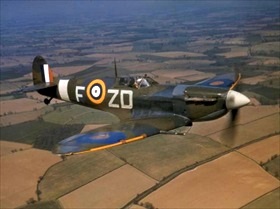 | 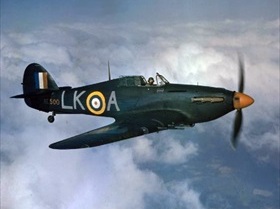 |
Left: The Supermarine Spitfire was a British single-seat, short-range, high-performance interceptor aircraft. The Spitfire was perceived by the public as the RAF fighter during the Battle of Britain. Spitfire units had a lower attrition rate and a higher victory-to-loss ratio than pilots flying Hurricanes, though the more numerous Hurricanes shouldered a greater proportion of the burden against the Luftwaffe. More than 20,350 Spitfires were built between 1938 and 1948.
![]()
Right: The Hawker Hurricane was a British single-seat fighter aircraft. Overshadowed by the Spitfire, the Hurricane became renowned during the Battle of Britain, accounting for 60 percent of the RAF’s air victories in the battle. Generally, Spitfires would intercept German fighter aircraft, leaving Hurricanes to concentrate on destroying German bombers. Over 14,500 Hurricanes were built between 1937 and 1944.
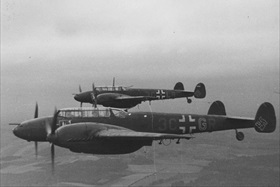 | 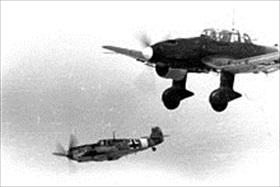 |
Left: The Messerschmitt Bf 110 was a twin-engine, two-seater heavy fighter. Its lack of agility in the air was exposed during the Battle of Britain, when some Bf 110-equipped units were withdrawn from the battle after very heavy losses and redeployed as night fighters (like the three-seater version shown in this photo from June 21, 1942, over France), a role to which the aircraft was well suited. Close to 6,200 Bf 110s were built.
![]()
Right: Junkers Ju 87 B two-man dive bomber and ground attack aircraft (foreground) and the single-seater Messerschmitt Bf 109 E, January 1941. The Ju 87, or Stuka, carried a pilot and rear gunner. The Stuka’s flaws became apparent during the Battle of Britain; poor maneuverability and a lack of both speed and defensive armament meant that it required heavy fighter escort to operate effectively. An estimated 6,500 Ju 87s were built by Germany. Bf 109s (like the one seen in the background) were the backbone of the Luftwaffe’s fighter force, serving famously during the Battle of Britain as bomber escorts; fighter-bombers; day-, night-, and all-weather fighters; and ground-attack aircraft. The Bf 109 was the most-produced fighter aircraft in history, with a total of 33,984 units produced between 1936 and April 1945.
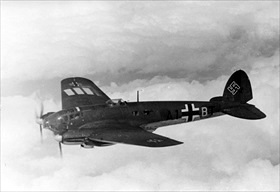 | 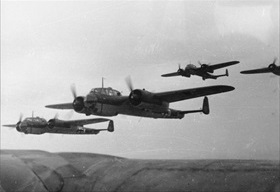 |
Left: A Heinkel He 111 over Belgium or France, September 1940. The He 111 was a fast medium bomber. It was the most numerous and the primary Luftwaffe bomber during the early war years. It was used as a strategic bomber during the Battle of Britain and up until then fared well, when its weak defensive armament, relatively low speed, and poor maneuverability were exposed. Roughly 6,500 He 111s were built between 1935 and 1944.
![]()
Right: Along with the Heinkel He 111, the Dornier Do 17, sometimes called the “flying pencil,” was the main bomber type of the Luftwaffe in 1939–1940. It was popular among its crews owing to its maneuverability at low altitude, but its effectiveness and usage was curtailed by its limited bomb load and range. Just over 2,100 Do 17s were built between 1934 and 1940.
Churchill’s Speech to Parliament, August 20, 1940: “Never in the field of human conflict . . .”
![]()

 History buffs, there is good news! The Daily Chronicles of World War II is now available as an ebook for $4.99 on Amazon.com. Containing a year’s worth of dated entries from this website, the ebook brings the story of this tumultuous era to life in a compelling, authoritative, and succinct manner. Featuring inventive navigation aids, the ebook enables readers to instantly move forward or backward by month and date to different dated entries. Simple and elegant! Click
History buffs, there is good news! The Daily Chronicles of World War II is now available as an ebook for $4.99 on Amazon.com. Containing a year’s worth of dated entries from this website, the ebook brings the story of this tumultuous era to life in a compelling, authoritative, and succinct manner. Featuring inventive navigation aids, the ebook enables readers to instantly move forward or backward by month and date to different dated entries. Simple and elegant! Click 











